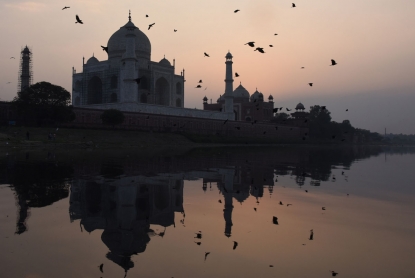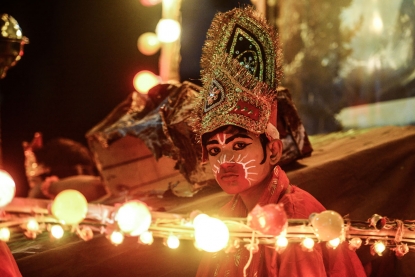My invincible Indian summer
"Having been based in Hong Kong and India for Agence France-Presse for the past seven years, I have not felt cold in almost a decade (Winter Olympics’ coverage aside). But as I left India after four fantastic and intense years as South Asia video coordinator, in order to join our regional headquarters in Washington DC, it was high time to dust my mouldy pullovers and treasured memories," writes video journalist Agnes Bun.
"I have worked in various countries in Africa, Asia and Europe; but my camera has never been as spoiled as in India. This country has fifty shades of vibrant colours and I wanted to pay tribute to them in writing and in a best-of video, as a final farewell to the fascinating people and landscapes I was lucky enough to film during my time here."
The following has been adapted from Agnes's book, "There is no poetry in a typhoon."
 The Taj Mahal, January, 2017.
(AFP / Dominique Faget)
The Taj Mahal, January, 2017.
(AFP / Dominique Faget)New Delhi -- Hubert Beuve-Méry, the founder of the French newspaper Le Monde, defined journalism as “contact and distance”. I have lived in India since early 2015, a country where the notion of personal space does not apply and distance is often challenging to implement. Contact, however... on the subway, women draped in embroidered veils rest their heads on my shoulders with an unsettling naturalness; on the train, children brush their noses against my book as they try to decipher mysterious characters. During religious festivals, demonstrations and political gatherings men aged 15 to 75 grab my butt without any qualms.
In many ways, these past four years in India have taught me more about endurance and survival instincts than my time spent in war zones. Like Albert Camus, I have, in the middle of winter, found within myself an invincible summer. Perhaps this is why India will always be a special place for me.
It’s undeniable, India hardens one—she allows her hennaed hand to be kissed before turning it for a brutal slap back to reality. Remembering the French philosopher Pascal’s dictum that humanity’s misfortune stems from an inability to know how to sit quietly in a room, my teenage room and its creature comforts seem far away from these crowded and dusty markets where rickshaws, street vendors, beggars and cows jostle me to a rhythmic cacophony that is in counterpoint to the tranquil melody of my childhood.
Where to start? With the 18 hours that I spent on a crowded train where the number of cockroaches exceeded the number of passengers? I had to sleep (or try to) with my headphones in my ears, lest one of them tried to crawl into my brain. With my forays into Maoist territory in the east, my foot still fragile from a recent fracture, while sitting astride the local police chief’s motorbike, sweating as he swerved to avoid possible land mines? I have also filmed rat eaters and snake hunters; I have walked on the floors of the dirtiest village in India and the so-called cleanest city in Asia. I have set my tripod up in slums with narrow alleys crisscrossed with pestilential gullies, in a dump encircled by vultures, in the central corridors of the Indian presidential palace adorned with velvet sofas, and at the heart of the marble palace of a princess who is both a descendent from Maharajahs and a collector of dinosaur fossils.
The air chokes me, the sun burns me, the spices spare my stomach (but not those of my visitors) and the waiter in this traditional restaurant insists on drawing a tilak on my forehead with red powder before allowing me in. This country does nothing by halves and to live here means to dive in head first. I have no regrets. On the back of a motorcycle inhaling miles of dusty Indian countryside, I experience an intoxicating freedom. On the road, I pass Indian clichés: cows, camels, nomads and multi-coloured saris. Just by living here, my own clothes become more colourful: I opt for brighter hues and shimmering scarves. My clothing choices still seem relatively restrained here, but on my rare visits to Europe they suddenly explode and I am struck by the sombre shades of black, grey and blue worn by the pedestrians around me. My camera has become habituated to these assaults of colour in India and would be uninspired in front of these desaturated scenes.
 An Indian widow dances during celebrations for Holi, the annual festival of colors, March 9, 2017.
(AFP / Dominique Faget)
An Indian widow dances during celebrations for Holi, the annual festival of colors, March 9, 2017.
(AFP / Dominique Faget)India has taught me a sense of detail. Photo colleague Dominique Faget and I went to a refuge for cows; just before we went through the door, he confided that he nearly wore his leather shoes before remembering that wearing the hide from this sacred animal would probably not be welcomed in this sanctuary. Laughing—and a little relieved—we crossed into the refuge.
India has also alerted me to the force of alternative realities. Educated people with flawless English have sworn to me that cigarettes do not harm the lungs, that yoga and sugar cane juice make it possible to rid the body of particulates of pollution, or that cow’s urine protects against radioactivity.
 Indian devotees take part in a ritual worship of the sun god during the Chhath Festival on the banks of the holy river Ganges in Varanasi on November 14, 2018. (AFP / Dominique Faget)
Indian devotees take part in a ritual worship of the sun god during the Chhath Festival on the banks of the holy river Ganges in Varanasi on November 14, 2018. (AFP / Dominique Faget)In India, more than anywhere else, I have realised the power of my camera which has allowed me to open doors to places, fantasized or despised, where I am not supposed to be. I’m very fortunate.
There is a State in India that literally shines brightly. In Jharkhand, the soil is littered with mica, a shimmery material that is used to manufacture cosmetics. The mica mines closed decades ago, but children continue to sift the earth to collect these precious particles and sell them for the equivalent of half a dollar a day. After driving on these glittering paths for hours, they appeared to us at a junction, girls and teenagers for the most part who ran off upon seeing my text and photo colleagues and me. But then, with hesitant, muffled steps and their shining fists clenched, they returned, suspicious as wolves.
I interviewed one of them. Lalita was seven years old with a stubborn look and a proud chin; she had never heard a school bell ring. She spoke Hindi with my colleague Abhaya Srivastava and me; I caught snatches of the conversation. She told us about entire days spent crouching, her eyes scrutinizing the ground, her hands bent like miniature excavators ploughing the earth to fill the trays in front of her. Each day she filled three.
There was a moment where I could no longer focus on her face. The camera hadn’t failed me, but I found I was crying. My colleague was as well. Lalita looked at us, her brows furrowing slightly, her eyes dry. I wonder if she has ever wept over her fate. She fidgeted and waited for us to end the interview before returning to collect the glitter that adorns the eyes of girls on the other side of the world.
When I think about my job and why I do it, I often think about Lalita. Some people I’ve interviewed keep a souvenir from our shoot. The presence of my camera in remote villages in India or in the Democratic Republic of Congo, for example, has often sparked laughter and offers a welcome distraction. Children stick their noses against my lens and touch the legs of my tripod, women giggle and cover their faces with their scarves, men stare at my screen over my shoulder and even old people, from afar, crane their necks. I try to maintain this freshness, even if there isn’t much time and footage accumulates. After all, in exchange for their time and kindness I can strive to make this day a little special for them.
But Lalita did not care for my camera. She did not need us or our tears, and her life probably did not deviate from its path following our reporting. Did her beautiful, resigned face thaw the hearts of people beyond my colleague and me? It’s this question that keeps me going.
I began in journalism under the naive illusion that I could change the world. Over these past few years, I’ve come to understand that it’s India that has changed me. Rubbing elbows with extreme human distress and experiencing the coldness of death and the immensity of loss pushes me to savour the small miracles of each encounter, as distressing as it might be. Like the American photographer Annie Leibovitz, I am not afraid to fall in love with the people you can see in my pictures. Camera in hand, I have both filmed and cherished the contours of these lined, chubby, wrinkled, soiled and sweaty faces. I am in love with the smiles that sometimes appear on their faces and I am grateful for the hope that they inspire in me.
 An Indian child artist takes part in a religious procession marking the Dussehra Festival in the old city of Allahabad on October 18, 2018. (AFP / Sanjay Kanojia)
An Indian child artist takes part in a religious procession marking the Dussehra Festival in the old city of Allahabad on October 18, 2018. (AFP / Sanjay Kanojia)





